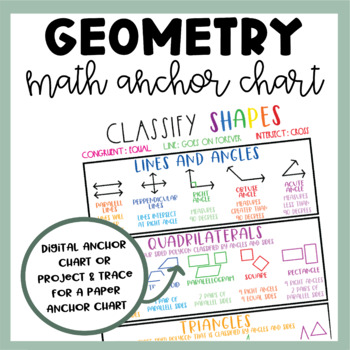Classify 2D Shapes Anchor Chart | Shapes and Angles | Quadrilaterals | Triangles
- Zip
What educators are saying
Also included in
- Introducing our comprehensive Fourth Grade Math Mega Bundle – your one-stop solution for mastering all the fourth-grade math standards! This bundle combines all the digital step-by-step instruction products from our collection, offering a treasure trove of resources to support your students' math lePrice $63.00Original Price $71.50Save $8.50
Description
DIGITAL ANCHOR CHART | 2D SHAPES | CLASSIFY QUADRILATERALS | CLASSIFY TRIANGLES | CLASSIFY LINES | TYPES OF LINES | PERPENDICULAR LINES | PARALLEL LINES | GEOMETRY VOCABULARY | RHOMBUS | TRAPEZOID | PARALLELOGRAM | SQUARE | RECTANGLE | SCALENE | ISOSCOLESE | RIGHT TRIANGLE | OBTUSE | EQUILATERAL | ACUTE | MEASURING ANGLES | GEOMETRY ANCHOR CHART | SHAPES ANCHOR CHART | ACUTE ANGLES | OBTUSE ANGLES | RIGHT ANGLES | STRAIGHT LINE ANGLES | DISTANCE LEARNING | DIGITAL LEARNING | 4TH GRADE MATH | 4TH GRADE GEOMETRY | CCSS G.1 | CCSS G.2 | CCSS G.3
On this anchor chart, you will find the different types of lines and angles. You will also find how to classify a quadrilateral according to sides and angles. Finally, there are the six types of triangles and how to identify them according to sides and angles.
This anchor chart includes two formats, one that can be traced onto an anchor chart paper (PDF) and another in picture form that can be placed in a slide show, digital classroom, Canvas page, webpage, etc.
These digital math anchor charts can be used digitally or you can project them to a wall, SmartBoard, whiteboard, or any flat surface and trace them onto your favorite anchor chart paper. I use a paper poster/anchor chart version to reference when teaching or working in small groups. I also insert the .png file in my presentations for reference.
For ideas, tips, and help with these products, check out my Instagram @shawintheclassroom to find multiple ways to use these anchor charts.



